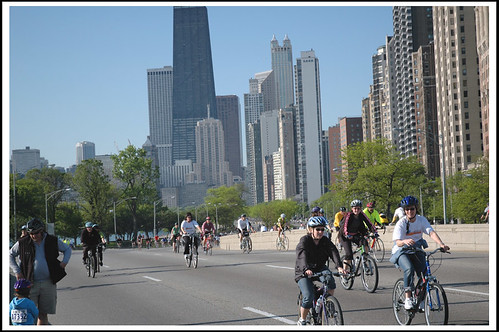
Americans are really good at complaining, but are high gasoline prices really the worst problem our society faces?
Hating every minute of it, Americans are slowly learning to live with high gasoline prices. For a nation accustomed to cheap fuel, big vehicles and sprawling suburbs, the adjustments are wrenching
[From Teeth Gritted, Drivers Adjust to $4 Gasoline]
Higher gas prices thus have the potential to increase bike use, convince Congress that funding public transportation (subways, buses, trains) is actually a good thing, increase urban density (do we as a nation really need another strip mall at the edge of town for yet another Wal-Mart, Starbucks and Best Buy? or another suburban housing development on previously pristine land? I say no), encourage automakers to build fuel efficient cars, and probably some other policy and lifestyle choices. I'm for it, even if I may have to suffer with paying more at the pump.
Not to mention, Americans still actually have cheap gas when compared to other first world countries:
I say again, as much as I hate to pour $60 of gasoline into my tank, perhaps for the long-term good of us all, it would be beneficial if gas prices went up to $5 a gallon.Americans spend 3.7 percent of their disposable income on transportation fuels. At its lowest point, that share was 1.9 percent in 1998, and at its highest, it reached 4.5 percent in 1981, said Ms. Johnson of Global Insight.
Still, despite the rise in energy prices, gasoline remains cheaper in the United States than in most industrialized countries. In France, for example, a gallon of gasoline costs about $7.70 at today’s exchange rates. Also, Americans pay less to drive a mile today than they did in 1980, once the impact of inflation and gains in fuel efficiency are taken into account, said Lee Schipper, a visiting scholar at the transportation center of the University of California, Berkeley.
Mr. Schipper estimates that the cost of gasoline for each mile traveled will be about 15 cents this year. That is nearly three times the low of 5.6 cents a mile reached in 1998, when fuel efficiency peaked and prices were at their lowest. But it is still cheaper than the record paid in 1980 of 17.1 cents a mile, adjusted for inflation.
The oil shocks of the 1970s and 1980s introduced the nation’s first efforts to curb consumption, including the first fuel efficiency standards and scaled-back speed limits. These had an impact on gasoline demand, which fell each year from 1979 to 1985. But then oil prices collapsed, political pressure evaporated, and many consumers lost interest in small cars.
“This is the wake-up call,” Mr. Schipper said. “We actually have a lot of choices, based on what car we drive, where we live, how much time we choose to drive, and where we choose to go. But you have built in a very strong car dependency. And when the price hits the fan, people have a hard time coping.”
For many people, higher energy costs mean fewer restaurant meals, deferred weekend outings with the family, less air travel and more time closer to home. Big-box retailers are suffering as customers balk at driving to the mall, airlines have slapped on steep fuel surcharges and carmakers have seen their sales slump. On Thursday, the Ford Motor Company announced production cuts because of sharply lower demand for sport utility vehicles and pickups.
In Los Angeles, Ron and Patricia Lowe spend more time at home on weekends, hanging out and barbecuing. They are also more likely to leave their house together now, scheduling fewer car trips and bundling their chores to cut the gas bill.
“If I go to the grocery store, and the mall and pick up some prescription, I do it in one shot,” he said.
